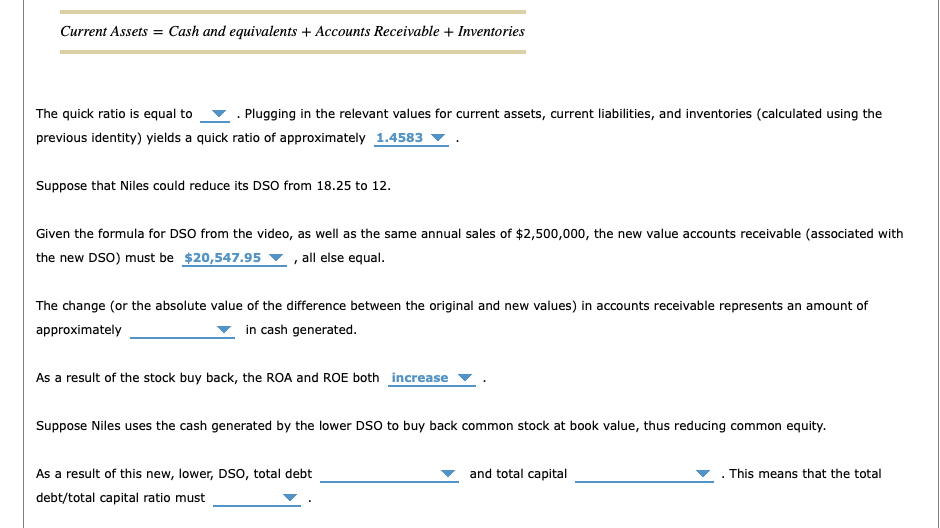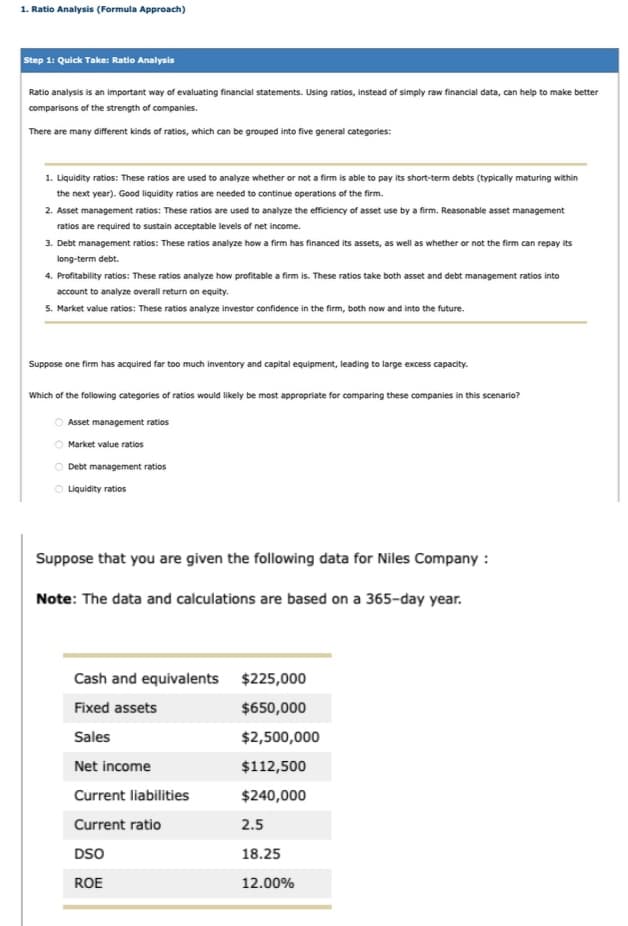The quick ratio is equal to Plugging in the relevant values for current assets, current liabilities, and inventories (calculated using the previous identity) yields a quick ratio of approximately 1.4583 Suppose that Niles could reduce its DSO from 18.25 to 12. Given the formula for DSO from the video, as well as the same annual sales of $2,500,000, the new value accounts receivable (associated with the new DSO) must be $20,547.95, all else equal. The change (or the absolute value of the difference between the original and new values) in accounts receivable represents an amount of approximately in cash generated. As a result of the stock buy back, the ROA and ROE both increase Suppose Niles uses the cash generated by the lower DSO to buy back common stock at book value, thus reducing common equity. As a result of this new, lower, DSO, total debt debt/total capital ratio must and total capital . This means that the total
The quick ratio is equal to Plugging in the relevant values for current assets, current liabilities, and inventories (calculated using the previous identity) yields a quick ratio of approximately 1.4583 Suppose that Niles could reduce its DSO from 18.25 to 12. Given the formula for DSO from the video, as well as the same annual sales of $2,500,000, the new value accounts receivable (associated with the new DSO) must be $20,547.95, all else equal. The change (or the absolute value of the difference between the original and new values) in accounts receivable represents an amount of approximately in cash generated. As a result of the stock buy back, the ROA and ROE both increase Suppose Niles uses the cash generated by the lower DSO to buy back common stock at book value, thus reducing common equity. As a result of this new, lower, DSO, total debt debt/total capital ratio must and total capital . This means that the total
Financial Accounting: The Impact on Decision Makers
10th Edition
ISBN:9781305654174
Author:Gary A. Porter, Curtis L. Norton
Publisher:Gary A. Porter, Curtis L. Norton
Chapter10: Long-term Liabilities
Section: Chapter Questions
Problem 10.2DC
Related questions
Topic Video
Question
Only answer fill in the blanks.

Transcribed Image Text:Current Assets = Cash and equivalents + Accounts Receivable + Inventories
The quick ratio is equal to . Plugging in the relevant values for current assets, current liabilities, and inventories (calculated using the
previous identity) yields a quick ratio of approximately 1.4583
Suppose that Niles could reduce its DSO from 18.25 to 12.
Given the formula for DSO from the video, as well as the same annual sales of $2,500,000, the new value accounts receivable (associated with
the new DSO) must be $20,547.95 , all else equal.
The change (or the absolute value of the difference between the original and new values) in accounts receivable represents an amount of
approximately
in cash generated.
As a result of the stock buy back, the ROA and ROE both increase
Suppose Niles uses the cash generated by the lower DSO to buy back common stock at book value, thus reducing common equity.
As a result of this new, lower, DSO, total debt
debt/total capital ratio must
and total capital
. This means that the total

Transcribed Image Text:1. Ratio Analysis (Formula Approach)
Step 1: Quick Take: Ratio Analysis
Ratio analysis is an important way of evaluating financial statements. Using ratios, instead of simply raw financial data, can help to make better
comparisons of the strength of companies.
There are many different kinds of ratios, which can be grouped into five general categories:
1. Liquidity ratios: These ratios are used to analyze whether or not a firm is able to pay its short-term debts (typically maturing within
the next year). Good liquidity ratios are needed to continue operations of the firm.
2. Asset management ratios: These ratios are used to analyze the efficiency of asset use by a firm. Reasonable asset management
ratios are required to sustain acceptable levels of net income.
3. Debt management ratios: These ratios analyze how a firm has financed its assets, as well as whether or not the firm can repay its
long-term debt.
4. Profitability ratios: These ratios analyze how profitable a firm is. These ratios take both asset and debt management ratios into
account to analyze overall return on equity.
5. Market value ratios: These ratios analyze investor confidence in the firm, both now and into the future.
Suppose one firm has acquired far too much inventory and capital equipment, leading to large excess capacity.
Which of the following categories of ratios would likely be most appropriate for comparing these companies in this scenario?
Asset management ratios
Market value ratios
O
O Debt management ratios
O Liquidity ratios
Suppose that you are given the following data for Niles Company :
Note: The data and calculations are based on a 365-day year.
Cash and equivalents
Fixed assets
Sales
Net income
Current liabilities
Current ratio
DSO
ROE
$225,000
$650,000
$2,500,000
$112,500
$240,000
2.5
18.25
12.00%
Expert Solution
This question has been solved!
Explore an expertly crafted, step-by-step solution for a thorough understanding of key concepts.
This is a popular solution!
Trending now
This is a popular solution!
Step by step
Solved in 2 steps

Knowledge Booster
Learn more about
Need a deep-dive on the concept behind this application? Look no further. Learn more about this topic, finance and related others by exploring similar questions and additional content below.Recommended textbooks for you

Financial Accounting: The Impact on Decision Make…
Accounting
ISBN:
9781305654174
Author:
Gary A. Porter, Curtis L. Norton
Publisher:
Cengage Learning

EBK CONTEMPORARY FINANCIAL MANAGEMENT
Finance
ISBN:
9781337514835
Author:
MOYER
Publisher:
CENGAGE LEARNING - CONSIGNMENT

Auditing: A Risk Based-Approach (MindTap Course L…
Accounting
ISBN:
9781337619455
Author:
Karla M Johnstone, Audrey A. Gramling, Larry E. Rittenberg
Publisher:
Cengage Learning

Financial Accounting: The Impact on Decision Make…
Accounting
ISBN:
9781305654174
Author:
Gary A. Porter, Curtis L. Norton
Publisher:
Cengage Learning

EBK CONTEMPORARY FINANCIAL MANAGEMENT
Finance
ISBN:
9781337514835
Author:
MOYER
Publisher:
CENGAGE LEARNING - CONSIGNMENT

Auditing: A Risk Based-Approach (MindTap Course L…
Accounting
ISBN:
9781337619455
Author:
Karla M Johnstone, Audrey A. Gramling, Larry E. Rittenberg
Publisher:
Cengage Learning